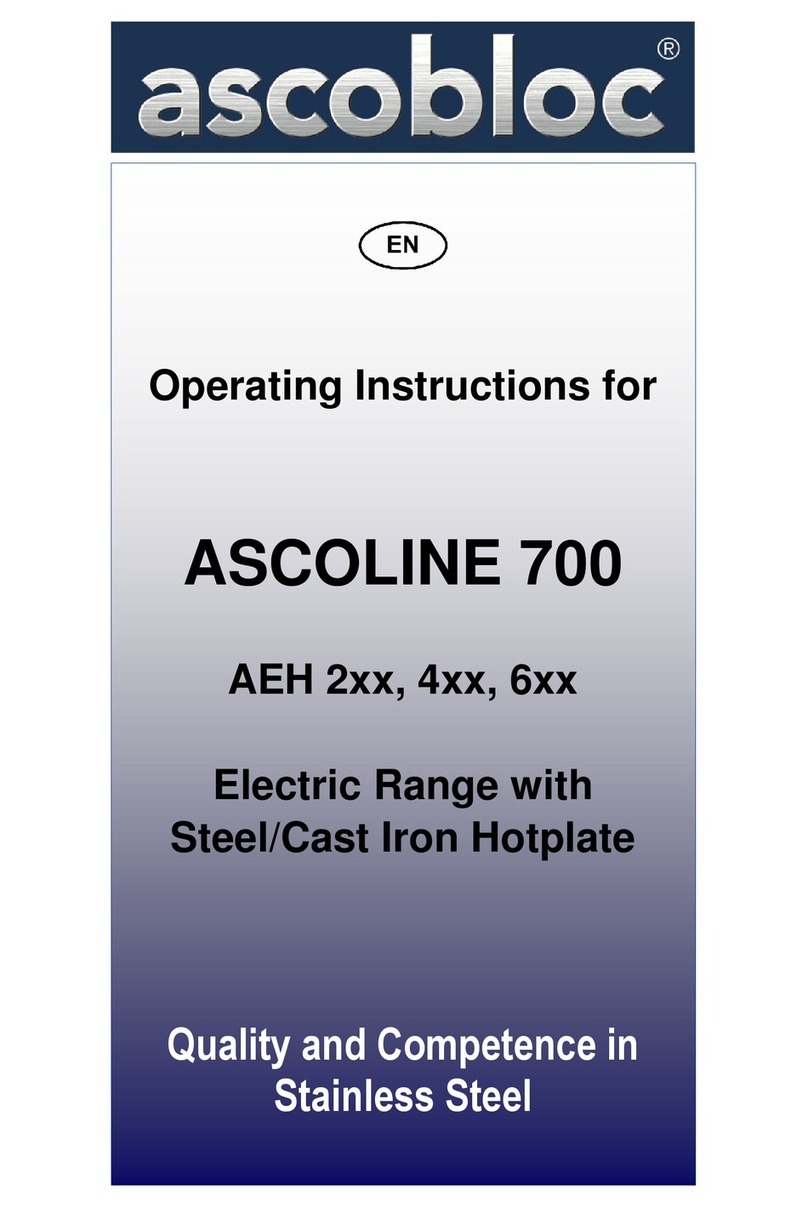
Operating Instructions Ascoline 850, MGH 2xx, 4xx, 6xx
ascobloc Gastro-Gerätebau GmbH 01156 Dresden, Grüner Weg 29 Germany
Tel.:
+49
351
4533-0
Fax:
+49
351
4533
433
E-mail: [email protected], MGH2XX.doc, Edition: 20.03.2008
Subject to change without notice!
4
4.2.2 Extraction of flue gas
Gas ranges are of Type "A", i.e. the connection of a flue gas system is not required.
Ventilation of the rooms where the appliances are set up has to comply with the regulatory guidelines in
the DVGW Worksheet G 634.
Appliance with gas-fired roasting and baking oven
The flue gas duct supplied is firmly fixed to the flue gas duct of the oven using the screws supplied. The
slant of the flue gas duct must point to the operating side of the appliance.
Connection location
The connection compartment is accessed from the front. It is located behind the front panel A (see
connection diagram). Once the connection has been made, screw the front panel back in place.
5 Proper Use of the Equipment
5.1 Operational start-up
•Remove the protective film before bringing into operation.
•Clean the equipment with dilute soap solution.
5.2 Functional test
5.2.1 Gas range
•Check that the burner cover is correctly seated.
•Check the supply pressure (flow pressure): Connect the pressure gauge to the pressure measuring
nipple of the main gas pipe.
•Bring the burners into operation and check whether the allowable supply pressure is maintained.
•Check whether the nozzles appropriate to the gas supply have been installed (see conversion
instructions). Close the sealing screw of the pressure measuring nipple again once the measuring is
finished!
•Bring all burners into operation. There is air in the lines prior to the first ignition so it takes somewhat
longer till the pilot flames can be ignited.
•Check for ignition from the pilot to the main burner, through-ignition and a regular flame pattern.
5.2.2 Appliance with gas-fired roasting and baking oven
•Inspect the flue gas duct of the oven.
•Check the switching function of the oven's temperature controller.
5.2.3 Appliance with electric roasting and baking oven
•Bring upper and lower heat separately into operation. The green indicator light for operational readiness
must light up.
•Set the knob for the top and/or bottom heat to 50°C. The yellow indicator light must light up. The yellow
indicator light goes out after a short time when the temperature set for the roast/baking oven is reached.
5.3 Operating
5.3.1 Gas cooking zones (see Figure 3)
Open the gas supply valve within the customer's supply before commissioning. Turn the cooking zone
control knob to "Star" and keep it pressed in. Ignite the pilot flame using the igniter and hold the knob in
the pressed-in position for about 10 seconds.
Parboiling at high power with a "large flame", simmering on a "small flame". The setting needed for
simmering depends on the condition of the cooking utensils and the quantity of food to be cooked.
With the knob at the "Star" position, the cooking zone burner is held in readiness; only the pilot flame is
on. Knob at the "Zero" position extinguishes the burner and the pilot flame of the cooking zone. If the
appliance is to be taken out of operation, first set all knobs to "Zero" and then close the gas supply valve
within the customer's supply.
5.3.2 Baking oven (optional)
Electric roasting and baking oven
•If the oven has convection heating as an extra, the changeover switch (6) must be in mode (II)
•The temperature is set by turning the knob (temperature controller),
•separately for top heat (2) and bottom heat (3)
•When the oven is switched on, the green or the yellow light is on
•When the preselected temperature is reached, the yellow light goes out
Electric convection oven:
•Set the changeover switch (6) to convection (I)
•The temperature is set by turning the knob (2) for top heat
•When the oven is switched on, the green or the yellow light is on
•When the preselected temperature is reached, the yellow light goes out
•The temperature in convection mode is limited to a maximum of 250°C.
































